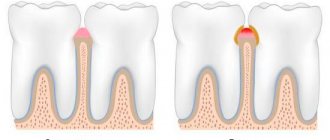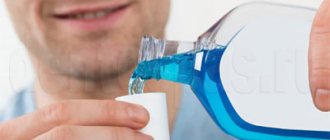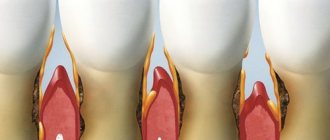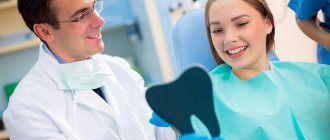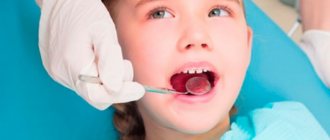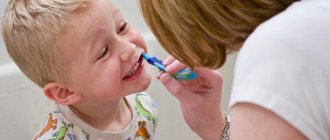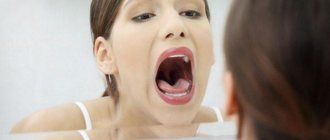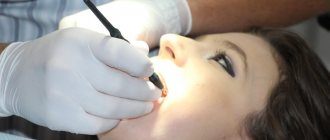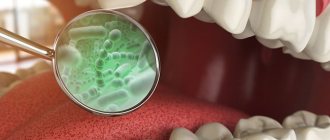Author of the article:
Soldatova Lyudmila Nikolaevna
Candidate of Medical Sciences, Professor of the Department of Clinical Dentistry of the St. Petersburg Medical and Social Institute, Chief Physician of the Alfa-Dent Dental Clinic, St. Petersburg
The human oral cavity is often called a mirror of the state of the body. A qualified dentist, after performing a visual examination of the oral mucosa and teeth, can determine what chronic diseases the patient has and advise him to see a specific doctor. Thus, diseases of the endocrine or nervous system, gastrointestinal tract or blood diseases can be diagnosed using the oral cavity.
At the same time, if there are chronic diseases in the oral cavity, then they, in turn, can become a provoking factor for the development of rheumatism, pyelonephritis and some other diseases. Remember how, for example, pregnant women before giving birth and patients before a planned operation need to obtain a certificate of oral sanitation. Therefore, prevention is very important for everyone. Moreover, we are talking not only about a beautiful and healthy smile, but also about health in general, and also, of course, about those funds from the family budget that will have to be spent on treatment at the dentist.
Prevention of oral diseases
When they talk about the prevention of oral diseases, they primarily mean:
- Self-regular oral care.
- Periodic visits to the dental clinic.
Why do you need to take care of your mouth? The fact is that after each meal, food particles remain on the teeth and mucous membranes of the mouth, as a result, upon contact with saliva, bacteria and microbes begin to multiply in the mouth, which ultimately leads to the appearance of caries, bad breath, plaque and dental plaque. stone
Some people, unfortunately, do not understand the importance of this procedure, erroneously claiming that animals don’t brush their teeth or anything. But we must not forget that animals live much shorter lives, and, most importantly, they monitor their diet, consuming sufficient quantities of food of plant origin.
About the prevention of dental diseases
Periodontal diseases and their causes
Periodontal diseases, popularly known as “periodontal disease,” are very common among the adult population of the world and the Republic of Belarus.
In the initial stage, inflammation of the gums, or gingivitis, is observed. The disease develops gradually. The color of the gum changes, it loses its elasticity, the surface of the gum becomes smoother and shiny. At first, the gums bleed only when touched (with a brush, when eating), then spontaneous bleeding appears. Bad breath is also associated with gum disease.
Unfortunately, many patients neglect the advice of the dentist, ignore bleeding when brushing their teeth and even spontaneous bleeding. But if gum inflammation is not treated promptly, the disease progresses and gingivitis turns into periodontitis. Over time, in such patients, the ligament that holds the tooth in the socket is destroyed. In addition, bone tissue is destroyed, pockets appear between the tooth and gum, suppuration may occur, and teeth become mobile.
The main cause of gum inflammation is dental plaque microorganisms, localized in the gingival part of the teeth, interdental spaces, and the toxins they produce. Factors that reduce the protective capabilities of periodontal tissues (general diseases, metabolic disorders, etc.) can contribute to the development of pathology.
Individual oral hygiene
Plaque bacteria play a critical role in the development of periodontal disease. Unfortunately, it is not possible to completely prevent the formation of dental plaque, since microorganisms are present in the oral cavity of every person and are part of their normal microflora.
Fig.1. Tongue brush
Already 2 hours after brushing your teeth, plaque formation begins again, which occurs within 24 hours. Therefore, the best method to eliminate the negative effects of bacteria is daily oral hygiene.
The frequency of brushing your teeth should be at least once a day. At the same time, it must be taken into account that it is not always possible to completely remove plaque from all surfaces of the teeth. Therefore, the generally accepted recommendation is to brush your teeth 2 times a day - in the morning after breakfast and in the evening before bed.
Dentists recommend brushing your teeth for at least 3 minutes so that not a single tooth is missed. It is important to pay attention to cleaning the tongue, the surface of which is cleaned with gentle scrubbing movements of the toothbrush. To clean the tongue, you can use special brushes or scrapers (Fig. 1)
Basic hygiene products:
Toothbrush -
one of the most common hygiene products. The retail chain has a large selection of toothbrushes with different design features. However, there is no scientific evidence that any design is the most effective. The most important thing is to master the correct technique for brushing your teeth and replacing your brush regularly (once every 3 months).
You should purchase those toothbrushes that have a certificate of state registration and are sold in sealed packaging, which should indicate its name, the degree of bristle hardness and information about the manufacturer.
Toothpaste
Based on the results of recent scientific research, for the prevention of dental diseases, it is recommended to brush your teeth with fluoride-containing toothpaste, which will help reduce the formation of plaque and strengthen the hard tissues of the teeth.
When purchasing, it is important to make sure that the paste includes fluoride, is hermetically sealed and contains all the necessary information on the packaging and tube:
- name, name of the product: the phrase “toothpaste” or other equivalent;
- production date and/or expiration date;
- all components - a complete list of ingredients (information about the presence of fluoride compounds in the toothpaste and the concentration of active fluoride is especially important; the maximum concentration of fluoride in the toothpaste should not exceed 0.15% (or 1500 ppm);
- name of the country of origin or responsible distributor; barcode, batch number and volume;
- toothpastes must have a certificate of state registration.
Dental floss
Rice. 2. Dental floss
Each tooth has surfaces that contact adjacent teeth. A toothbrush cannot remove plaque from these areas because the bristles cannot penetrate the narrow spaces between teeth. This leads to the fact that up to 50% of dental plaque can remain on the contact surfaces of the teeth. Dental floss is used to clean teeth from these surfaces (Fig. 2).
Experts agree that if you have developed skills in using floss, their appearance is not significant.
Rice. 3. Flosset
For those patients who are just mastering the flossing technique, the use of waxed threads is considered more preferable, since they are easier to insert into the interdental spaces and do not fray or break.
To facilitate the use of dental floss, special holders are proposed - flossets (Fig. 3).
Their use is relevant for people who cannot master the technique of using floss, especially for people with impaired mobility of fingers and hands.
Additional hygiene products
Interdental brushes
Rice. 4. Brush.
Interdental brushes (Fig. 4) are made of nylon bristles fixed to a thin wire base. The shape of the working part of the brush can be conical or cylindrical. Cleaners also vary in size. The use of interdental brushes is relevant in the presence of open interdental spaces formed as a result of gum atrophy and exposure of tooth roots.
Rinse aids
Rinse aids are divided into two large groups.
Rice. 5. Rinse aids
The first ones are used before brushing your teeth to facilitate the removal of plaque with a brush and paste. The main purpose of using such rinses is to soften plaque on the teeth.
Others are used after brushing; they prevent bacteria from adhering to the surface of the tooth. Rinses containing antiseptics reduce the amount of plaque on tooth surfaces.
However, their use does not reduce the importance of daily hygiene procedures, which are basic for removing plaque.
In some cases (after surgery, in the presence of diseases of the mucous membrane and gums), the dentist may recommend the use of special antibacterial rinses. However, they are not intended for constant, regular use, but are used only during periods of exacerbation of dental diseases. With prolonged use of the same agent with antimicrobial activity, its effectiveness is significantly reduced due to the adaptation of the oral microflora to it.
Should dentures be cleaned?
Rice. 6. Brushes for dentures
It is important to know that dental plaque and tartar can form on the surface of removable and non-removable orthopedic structures (prostheses).
Therefore, you should clean your dentures with a toothbrush and toothpaste.
There are special brushes (Fig. 6) for cleaning the surface of removable orthopedic structures, and to clean the spaces under bridges, it is necessary to use superfloss.
Rice. 7. Superfloss
Superfloss is a thread consisting of three parts. The first part is a solid fiber for guiding the thread into the interdental space. The second part - loose, “fluffy”, has a pronounced absorbent ability - is intended for cleaning wide interdental spaces, spaces under fixed orthodontic arches, under splinting structures, under the washing parts of bridges, between implanted implants. The third part of the thread is regular floss.
As for removable dentures, it is recommended to remove them from the mouth at night and store them in a glass of water with special cleaning tablets dissolved in it.
PROFESSIONAL HYGIENE
Rice. 8. Professional hygiene
Over time, plaque mineralizes and turns into a hard calcified layer - tartar, which also plays a certain role in the development of inflammatory periodontal diseases.
If tartar is not removed in time, it will injure periodontal tissue. And most importantly, the stone promotes the accumulation of plaque, being a good retention point.
Professional hygiene (Fig. involves removing plaque and tartar by a dentist using special hand instruments or ultrasound, as well as polishing teeth using special brushes and rubber bands with pastes containing abrasives. This procedure is recommended for all patients at least once every six months, and in some cases (for example, with periodontal diseases) and more often.
involves removing plaque and tartar by a dentist using special hand instruments or ultrasound, as well as polishing teeth using special brushes and rubber bands with pastes containing abrasives. This procedure is recommended for all patients at least once every six months, and in some cases (for example, with periodontal diseases) and more often.
Thus, to avoid periodontal disease, you must strictly adhere to the following rules:
- Brush your teeth thoroughly twice a day with a toothbrush and toothpaste, and use dental floss at least once a day. If necessary, use additional hygiene products.
- Use fluoride compounds (fluoridated salt, fluoride toothpaste) throughout your life.
- Visit the dentist regularly (once every 6 months) to remove dental plaque (professional hygiene).
Healthy teeth and gums are the key to overall health
Brushing your teeth with a toothbrush
The most important thing in preventing oral diseases is brushing your teeth. Every person, regardless of age, including children, should brush their teeth morning and evening. Moreover, observing certain rules.
- You need to brush your teeth for at least five minutes.
- Brush your teeth with rotational movements, otherwise, if you brush straight, the plaque will simply be driven into the gum pockets and between the teeth.
- Do not press the brush too hard to avoid damaging the enamel.
- When brushing your teeth, mentally divide all your teeth into four sections and brush each one separately so as not to spread germs throughout the jaw.
- You need to brush not only the teeth from above, but also near the gums, at the base, and also the gums themselves.
- Dentists recommend placing the brush at an angle of 45 degrees when brushing your teeth.
- First you need to brush the far teeth of the upper jaw, then the front teeth, turning the brush vertically, and then start cleaning the teeth of the lower jaw. Finish brushing your teeth by massaging your gums and brushing your tongue.
- In this case, you should take no more than a pea-sized amount of toothpaste.
Dental irrigators
Externally, they look like an electric toothbrush, which is equipped with a special tip that performs a kind of hydromassage. Water supplied through it under pressure cleanses the tooth surface and hard-to-reach places, including performing cleansing procedures on the cheeks, tongue and gums.
It should be remembered that taking all preventive measures does not relieve you of the need for regular monitoring by a dentist.
How to choose the right toothbrush
Just as important as brushing your teeth is choosing a good toothbrush. Experts advise purchasing a brush with artificial bristles, which is considered more hygienic, practical and durable. As for the optimal degree of hardness, if the patient does not have any special indications, a regular brush of medium hardness will suit him.
It is also worth paying attention to the size of the toothbrush - optimally it should cover three teeth.
We must not forget that the brush needs to be changed periodically. It’s difficult to say how often to do this, because for some the brush can wear out in a month, while for others it can last two to three months. This depends on many factors, in particular, how often you brush your teeth, with what force you do it, how long the procedure lasts, and what toothpaste you use.
Therefore, some dentists advise purchasing toothbrushes with colored tufts of bristles, which are indicators. On a new brush they are always bright, and when the bristles wear out, they take on a pale blue tint. Noticed this on your toothbrush? It's time to go to the pharmacy for a new one.
If your brush does not have such indicators, simply change it at least once a quarter.
Recently, electric toothbrushes have become popular, although the attitude towards them from professional dentists is rather ambiguous. Therefore, before purchasing such a modern brush, it is better to consult your doctor.
Battery-powered teeth polishing devices are also available on the market. According to dentists, they can be used, but not often, as they can damage the enamel.
Diet for the prevention of caries in children
Caries bacteria feed on sugar: glucose, fructose or sucrose. Sweets are the main ally of this disease. Although children love them, they should not overuse them. Sugar in desserts not only contributes to the development of tooth decay. It also includes refined carbohydrates such as white sugar, flour and processed foods. The following methods should be followed: dental caries in children
- Eliminate sugar from your diet.
- Replacing colored drinks with water.
- Avoid processed foods.
- Refusal of products containing preservatives.
It often happens that the child drinks colored and carbonated drinks, eats cookies, chips, lollipops or candies as a snack, and drinks milk or cocoa before bed. All of these everyday activities can lead to tooth decay in young children. To prevent serious illness, which is unfortunately not getting enough attention, you need to choose healthier alternatives to popular snacks, sweets and drinks.
The correct level of minerals and nutrients, the dose of vitamins, the rational dosage of sugars and the solid consistency of food are factors that can effectively prevent the formation and development of dental caries in young children. Doctors are confident that every child will be grateful to their parents for developing good habits, proper oral hygiene and diet, which affects the life and health of children not only now, but also in the future.
To prevent caries treatment in young children, it is worth conducting a preventive dental examination every 6 months and removing tartar. Children should be constantly encouraged to prevent tooth decay because it is easier to prevent than to cure, especially when it hurts, and visits to the dentist are frequent and unpleasant for the child.
Toothbrush care
There are also rules on how to care for your toothbrush so that it helps maintain oral health and does not harm your teeth and gums. What is needed for this?
- Never give your own toothbrush or borrow someone else’s toothbrush, even from your own family members.
- After each brushing procedure, the brush should be washed with soap. You can use it next time only when it is completely dry.
- It is advisable for each person to have two brushes: one for use at home, the second “travel brush” to take with you on trips.
- To clean the brush from germs, you can use various antiseptics or rinses.
- Each brush should be dried in a cup separately from the others, without touching them. Ideally, you can use a “cap” or case for each brush.
What is caries in children?
Tooth decay in infants under one year of age is the destruction of mineralized tooth particles caused by the action of acids on the tooth surface produced by plaque bacteria.
An important element of this process is the imbalance between mineralization, which is the calcification of the tooth, and demineralization, literally the loss of tooth structure. Factors and causes involved in the formation of dental caries in young children include:
- bacteria present in dental plaque
- carbohydrates, that is, sugars present in food,
- predisposition of dental tissues to decalcification due to insufficient mineralization,
- composition of saliva, its quantity and ability to deoxidize the contents of the oral cavity
- time of exposure of the above factors to dental tissue.
The process of tooth decay in young children begins with the erosion of tooth enamel. This is a white cavity that does not yet require dental care and may disappear with calcium and fluoride supplements. If adequate caries prevention is not applied at this stage, the deeper tissues of the tooth are affected. Caries in young children can occur on the first tooth that emerges.
How to choose toothpaste
When choosing a toothpaste, it is a good idea to consult your doctor. Do not get carried away with abrasive toothpastes: it is better to alternate them with regular ones. For children, you should buy special children's pastes, according to their age. For people with sensitive gums and teeth - professional pastes.
In general, all toothpastes that are available in pharmacies today can be divided into:
- hygienic, which are suitable for everyone, as they do not contain special medicinal components;
- therapeutic and prophylactic: they can also be used daily as a prophylactic against various diseases;
- medicinal: they should be used only as prescribed by a doctor.
If for some reason a person does not like toothpastes, then he can use special dental gels to clean his teeth. However, we must not forget that in terms of their abrasive properties they are significantly inferior to pastes.
And during the day, when it is not possible to use toothpaste, or after morning or evening brushing, you can use dental elixirs.
We recommend Asepta toothpastes. They are designed to meet all oral hygiene requirements. The components they contain effectively clean teeth, strengthen enamel, prevent the occurrence of caries, and gently freshen breath.
Prevention of caries in children
How to avoid caries in a child? There are simple steps you can take to reduce the likelihood of it occurring.
- Brush your child's teeth as soon as their first teeth appear. At first, you can use sanitary napkins with xylitol.
- Don't lick your baby's pacifiers or let your baby eat from a spoon. This can transfer bacteria from the mouth to the baby and increase the likelihood of tooth decay on newly erupted teeth.
- Avoid giving your baby juices or sugary formulas at night or at bedtime. After your last meal, you need to brush your teeth! If your baby is breastfed, after a year, reduce nighttime feedings; remember that breast milk is also sweet and can cause the development of caries.
- From 1-1.5 years old, regularly visits the pediatric dentist (once every 3-4 months).
- Don't forget about regular oral hygiene at least twice a day for 2-3 minutes.
- Brush your child's teeth yourself until he is 4-5 years old, so be sure to help him with brushing. Until the age of 8-9 years, a child still cannot brush all his teeth correctly, even if he knows how to do it correctly.
- Let your baby's diet be rich in micronutrients. Encourage your child to chew carrots and apples to reduce plaque buildup and strengthen gums.
- Professional oral hygiene is not a luxury, but an extremely useful procedure, because only a dentist can remove hard plaque. Also, if possible, go through the procedures of enamel mineralization and fissure sealing on young permanent teeth with your child. These measures are a good prevention of dental caries in children.
Clinical researches
ASEPTA toothpastes are clinically proven effective. For example, repeated clinical studies have proven that regular use of preventive toothpaste ASEPTA SENSITIVE for a month can reduce bleeding gums by 62%, reduce the sensitivity of teeth and gums by 48% and reduce inflammation by 66%.
In addition, it was proven that regular use of professional toothpaste ASEPTA COFFEE AND TOBACCO for a month improved the hydration of the mucous membrane by 3.3 times, the remineralizing efficiency increased by 3.9 times, at the same time, the cleansing effect has increasing dynamics and reaches 60.5% at 4 weeks of use.
Sources:
- Clinical studies of antisensitive toothpaste “Asepta Sensitive” (A.A. Leontyev, O.V. Kalinina, S.B. Ulitovsky) A.A. LEONTIEV, dentist O.V. KALININA, dentist S.B. ULITOVSKY, Doctor of Medical Sciences, Prof. Department of Therapeutic Dentistry, St. Petersburg State Medical University named after. acad. I.P. Pavlova
- Report on determining/confirming the preventive properties of toothpaste “ASEPTA PLUS” COFFEE and TOBACCO Author: doctor-researcher A.A. Leontyev, head Department of Preventive Dentistry, Doctor of Medical Sciences, Professor S.B. Ulitovsky. First St. Petersburg State Medical University named after. acad. I.P. Pavlova, Department of Preventive Dentistry
- Report on determining/confirming the preventive properties of toothpaste “ASEPTA PLUS” GENTLE WHITENING” Author: doctor-researcher A.A. Leontyev, head Department of Preventive Dentistry, Doctor of Medical Sciences, Professor S.B. Ulitovsky First St. Petersburg State Medical University named after. acad. I.P. Pavlova, Department of Preventive Dentistry

